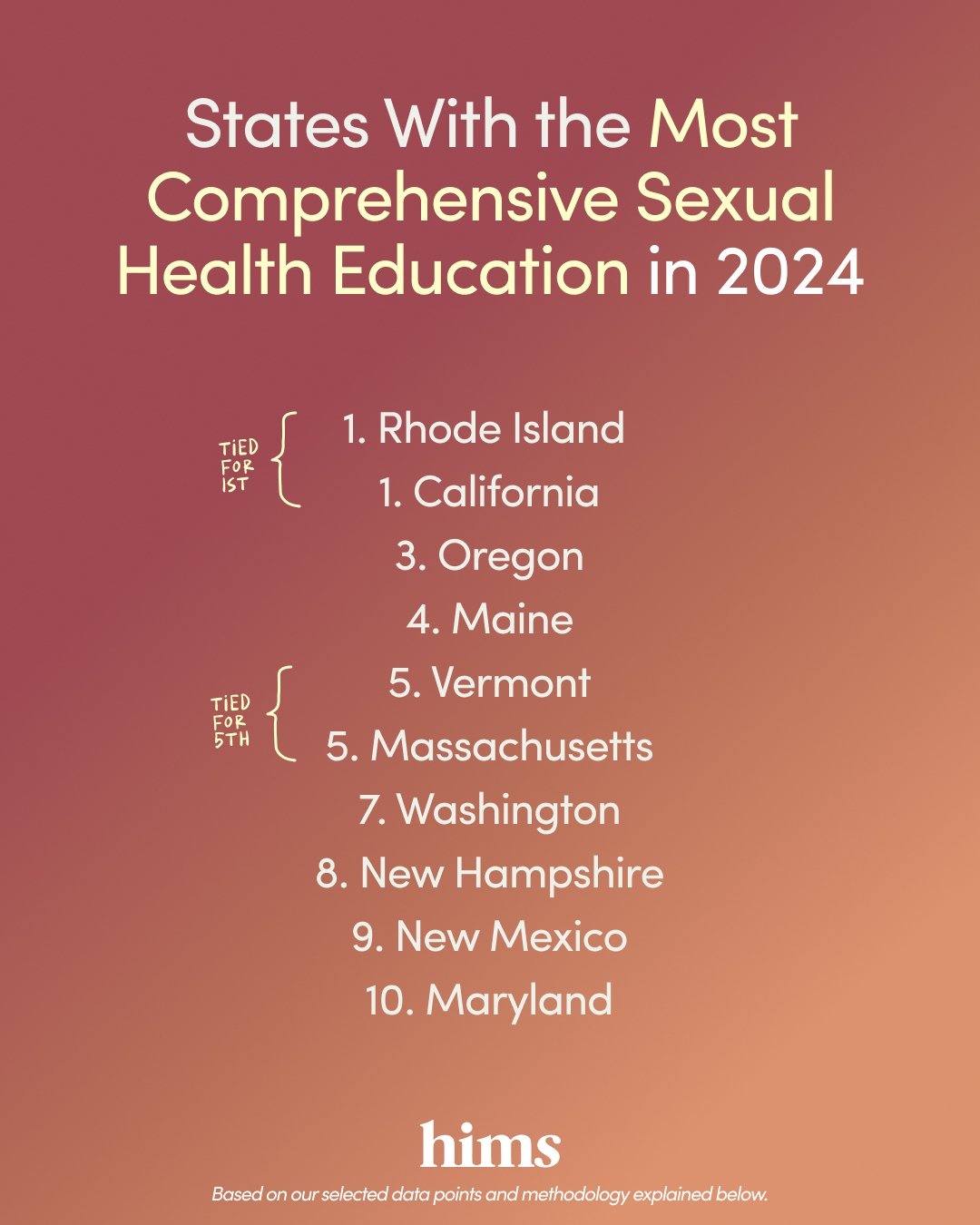
Rhode Island and California get an A in Sex Ed: See how other states stack up in new study
This story was produced by Hims and reviewed and distributed by Stacker.
Rhode Island and California get an A in Sex Ed: See how other states stack up in new study
Research shows that comprehensive sex education reduces teen birth rates and sexually transmitted infections, improving outcomes for young people. However, the implementation of sex education is left to the states, causing vast differences in what adolescents learn (and don't learn) about sex.
Hims set out to find the states providing the most comprehensive curriculum and services inside schools, using the following data sets to rank each state.
- Comprehensive curriculum in schools: Hims found the number of teachers in each state that teach high schoolers three core sexual health topics on how to access reliable health information, condoms, and preventative care related to sexual and reproductive health.
- Professional development for health education teachers: States vary widely in how much teachers are supported in learning the best instructional strategies for sex education. Hims looked at CDC data of health teachers who took workshops, continuing education, or any other kind of development related to sexual health education instruction best practices.
- In-school referrals for sexual health services: Referral programs are designed to connect students with community health providers in order to increase access to contraception services, STD testing, and counseling services.
- State mandates: Hims scored each state on its mandates for sexual and HIV education as well as the quality of curriculum requirements.

Key Findings
- The states with the most comprehensive sexual education were overwhelmingly concentrated in New England and the West Coast, with a few exceptions like New Mexico and Maryland.
- Connecticut, Kentucky, and North Dakota stand out for providing professional development opportunities for health teachers.
10 States With the Most Comprehensive Sexual Health Education
1. Rhode Island and California (tied)
3. Oregon
4. Maine
5. Vermont and Massachusetts (tied)
7. Washington
8. New Hampshire
9. New Mexico
10. Maryland
Sexual Health Education by State: Trends and Insights
Hims looked at several data categories based on how schools support sexual health education, what referrals are offered, and what kind of mandates are enforced. Here's a look at the top states in each individual category.
States with the highest percentage of teaching all three topics related to sexual health services:
These topics identified by the CDC include: how to access valid and reliable health information, products, and services; how to obtain condoms; and reproductive and sexual health preventive care, such as screenings and immunizations.
- Maine
- Maryland
- New Hampshire
States with the most sex ed teacher professional development:
The CDC surveyed health teachers who took workshops, continuing education, or any other kind of development within the last two years related to sexual health education instruction best practices. Here's which states had the most professional development for sex ed teachers.
- Connecticut
- Kentucky
- North Dakota
States with the highest percentage of schools providing referrals for sexual health services:
School referrals for sexual health services could include HIV testing, STD testing, pregnancy testing, access to condoms and lubricant, access to other contraceptives, and HPV vaccine administration.
- Delaware
- Vermont
- New York
States with the most comprehensive sexual health education mandates:
State sex education mandates vary widely, so Hims scored each one on whether or not sex ed and HIV ed are required, as well as additional characteristics that ensure quality, comprehensive curriculum is presented within schools.
1. California and Rhode Island (tied)
2. New Jersey, Oregon, Tennessee, and Washington (tied)
3. Hawaii, Maine, and North Carolina (tied)
Sex Ed in the U.S.: 50 States Ranked
1. Rhode Island and California (tied)
3. Oregon
4. Maine
5. Massachusetts and Vermont (tied)
7. Washington
8. New Hampshire
9. New Mexico
10. Maryland
11. Tennessee
12. Delaware
13. Nevada
14. North Carolina
15. Hawaii
16. West Virginia
17. Montana
18. Minnesota
19. Kentucky
20. New Jersey
21. Illinois
22. Iowa and Ohio (tied)
24. North Dakota and Utah (tied)
26. Missouri
27. South Carolina
28. Connecticut
29. Wisconsin
30. Michigan
31. Florida
32. Mississippi
33. Nebraska
34. Georgia, Pennsylvania, and Virginia (tied)
37. Kansas
38. Arizona
39. New York and Texas (tied)
41. Indiana and Oklahoma (tied)
43. Alabama
44. Louisiana
45. Colorado
46. Alaska and Idaho (tied)
Note: Arkansas, South Dakota, and Wyoming had no reporting available. Based on data collected in October 2024. Get the data.
Data and Methodology
Hims based its rankings on data collected within two categories: in-school education and services and state mandates.
Points were assigned based on the percentage of schools in the state providing the following in-school sexual health education and services:
- Percent of teachers that taught all three sexual health services topics in high school: how to access valid and reliable health information, products, and services related to HIV, other STDs, and pregnancy; how to obtain condoms; and preventive care such as screenings and immunizations (CDC School Health Profiles Explorer).
- Percent of health teachers who received professional development within the last two years on using a variety of effective instructional strategies to deliver sexual health education (CDC School Health Profiles Explorer).
- Schools that provide referrals for sexual health services (CDC School Health Profiles Explorer).
Points were also given for characteristics of state sex ed mandates (Guttmacher Institute):
- Whether or not sexual education and HIV education are mandated
- Whether or not sexual education curriculum must be: medically accurate, age appropriate, culturally appropriate and unbiased, cannot promote religion
Both overall categories were ranked by the total number of points, then averaged to find the final placement on this list. That gives equal weight to how sex ed is approached at the state level and within individual schools.
Sexual Education Resources
For quality sex education for yourself or a teen, check out the following resources that can be accessed from anywhere.
- Expert-backed content: Online platforms give so much access to information on sex, but it's important to distinguish between what's accurate and what's not. When looking for online resources, look for content that is science-based and expert-backed, reviewed by medical professionals to ensure accuracy.
- Community health clinics: Community health organizations are led by medical professionals and offer information available both online and in person. They're also a great resource for accessing sexual health services such as contraception and testing for sexually transmitted infections.
- Primary care physician: It's important to find a primary care physician you can trust and feel comfortable asking questions to. As teens get older, it's common practice for parents to leave the room for at least part of the well-check appointment so any sensitive questions and concerns can be addressed. Building a comfortable relationship with your PCP in which you have open conversations about sexual health can help increase comfort levels if you're ever experiencing any issues down the road, like premature ejaculation or erectile dysfunction. Having an expert you can trust and feel comfortable talking to can go a long way.



